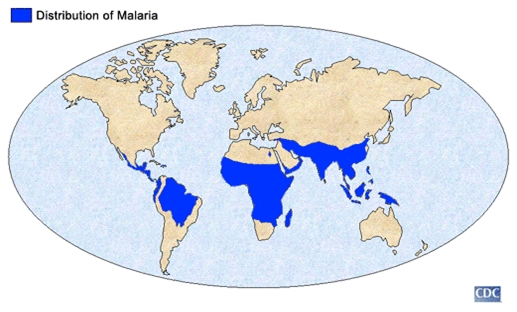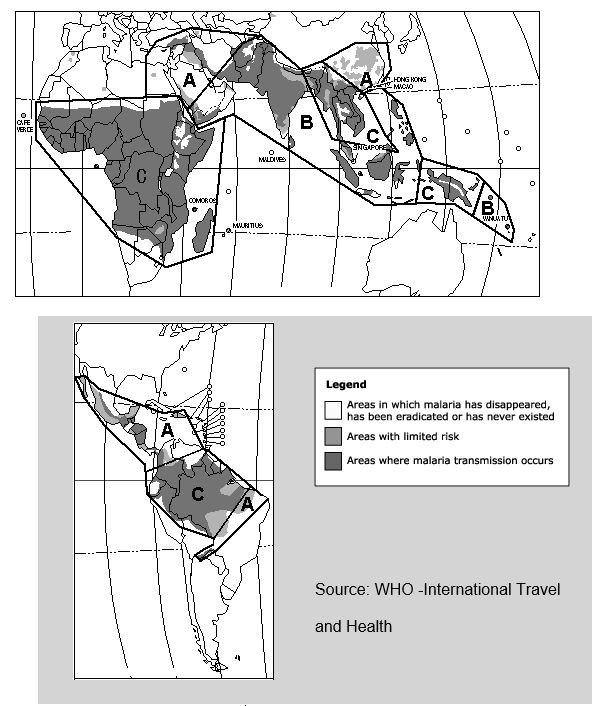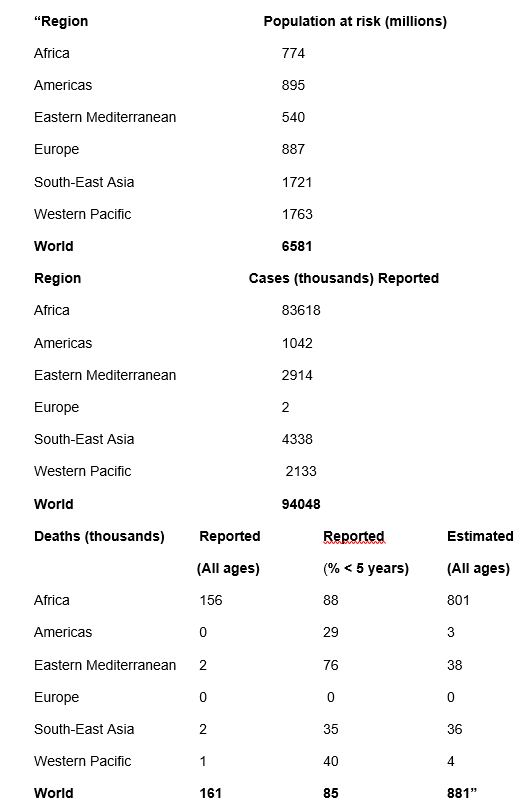The Problem
Malaria is a dangerous disease caused by a parasite through the bite of mosquito. Half of the population of the world is at risk, especially in poor countries, because of malaria. According to the report of World Health Organization (WHO), approximately 2.7 million deaths occur every year, and in every thirty seconds a child dies due to malaria. There are four types of human malaria. “They are plasmodium falciparum, plasmodium vivax, plasmodium malariae and plasmodium ovale.” (Malaria updated 2009, Key facts, para. 3).
Malaria is a preventive and curative disease, but it is often a fatal disease when it is left without proper treatment. Major symptoms can be observed after 15 days of infection including fever, chills, vomiting and headache. Sub-Saharan Africa, Asia, Latin America and Middle East of Europe are the main regions where the disease is more predominant. Travelers, HIV infected individuals and non-immune pregnant women are at high risk of malaria. Some countries have heavy financial burden because of malaria and spend around 40% of public expenditure in connection with eradication of malaria. Following are certain important facts related to malaria.
The Agent
”Malaria is a potentially fatal blood disease caused by a parasite that is transmitted to human and animal hosts by the Anopheles mosquito.” (What is Malaria, 2001, Malaria: a mosquito-borne disease of the blood, para 1) This parasite belongs to plasmodium species. A person gets infected by malaria through the bite of mosquito. Through this bite the pathogen gets into the blood stream of the individual and reaches the liver and there the parasite is multiplied in large numbers, and finally infects the red blood cells.
The Condition
There are socio-economic conditions that precipitate the vulnerability of malaria. Inadequate health structures, low economic growth, lack of preventive measures and fewer alerts to the symptoms are the main factors that lead to increase in cases of malaria. The rate of transmission is higher from August to December in the region of west central Africa. The transmission of malaria is dependent on some factors such as “temperature and extent of water for larval breeding, seasonal fluctuation of mosquito populations, vectoral capacity of the common vector species and duration of conditions suitable for mosquito survival.” (Shiff, 2006).
Morbidity
The term morbidity refers to the “rate of disease or proportion of diseased persons in a given locality, nation, etc” (Morbidity definition, 2009). It was calculated that almost 250 million cases of malaria occurred in 2006. This affected almost 3.3 billion people from 110 countries which account for half of world population at that time. In these countries, it is a pandemic claiming the lives of many.
Out of this 3 billon people, “2.1 billion were at low risk (< 1 reported case per 1000 population), 97% of whom were living in regions other than Africa” (Summary, 2008, p.viii). The remaining 1.2 million are at high risk category that is the incidents of malaria infections is at the rate of greater than or equal to 1 per 1000 population. This category of people were living mainly in the African region (49%) and also in the South East Asia region (37%)
Mortality
Nearly 250 million cases of malaria were reported in 2006 resulting in nearly one million deaths world wide. Children in Africa are found to be the most vulnerable group, as the major part of the deaths due to malaria infections have occurred in this group. From 1990 to 2003, deaths caused by malaria were reported in more than 50 countries world wide. According to W.H.O., a child dies in all 30 seconds due to malaria.
Host Factors
The hosts of malaria infections around the globe are showing certain characteristic features. Some host factors are shown below:
Ethnic group
Certain ethnic groups contract malaria. “Fulani in Africa have a different genetic signature in the genes that affect how quickly and effectively the immune system can act to build up resistance to malaria.” (Genetic differences explain degree of susceptibility to malaria updated 2008, para.2). These people are genetically equipped to produce antibodies when they are about to get infected. This is because they have a different genetic make up which enables their immune system to respond more quickly to infections.
Sex and Malaria
Married women are more prone to get infected with malaria. World Health Organization’s reports point out that among non-immune pregnant women, malaria causes miscarriage and 10% of maternal deaths are found to be due to malaria infections. Additionally, HIV affected pregnant women also are at high risk because of reduction in immunity power caused by HIV. In addition to this, there is no specific relation between sex and infection of malaria.
Marital Status
There is a study indicating “that married women are willing to pay more to prevent malaria in their household than married men.” (Lampietti,1999). So there exists a greater chance for the unmarried persons to get infected with malaria.
Age and Malaria
A study conducted by the department of epidemiology in Thailand shows that “The age groups of 15-24 and 25-34 years exhibited the majority of infections (73.7%).” (Malaria infection updated 2004).
Nativity
More cases of malaria are observed in Africa, Latin America and Asia than any other countries. Most of these countries are low income countries. The Figure.1 shows the entire distribution of malaria worldwide.
This disease can be seen predominantly in Africa and south East Asian countries..

Environmental attributes
Geographical areas

Fig.2 shows the current status of malaria in the seven continents. In the Australian continent as well as Northern part of Africa and extreme Northern and Southern parts of America this disease has disappeared, has been eradicated, or has never existed. In Antarctica no incidents of malaria were reported. In the central region of Africa, American continent as well as major parts of Asia this disease has occurred severely in the past and is still a health problem. Areas having low or limited risk are coming under this.
Some facts of worldwide malaria infections are given below:

Besides this, some factors related to society are shown below in connection with malaria. They are:
Social factors and economic factors
The related social and economic factors of malaria are varied. In social aspects the movement of population from one region to another is found to be a favoring factor for the spreading of this disease. There exists a huge gap between actual knowledge and the belief about malaria. This, in turn, will act as a contributing factor to an increased rate of mortality due to this disease. This is because the people will hold to their belief rather than seek medical help. This occurs as a result of lack of knowledge about malaria infection and related health problems. “Where malaria prospers most, human societies have prospered least.” (Sachs, & Malaney, 2002).
Malaria is a communicable disease which has spread all over the world. In some studies it is found that malaria and the extent of poverty are correlated. Malaria impairs the development of a nation in several ways. Malaria infection causes tremendous financial burden on the people as well as on the nation. In this situation the government has to prevent this disease rather than going ahead with developmental activities.
Occupation and Education
The educational status of the members of a community has a crucial relation with vulnerability of that community to malaria or any other communicable diseases. When education level is high, the people will be more aware about prevention and control of malaria. This will, of course, reduce the chance of getting infected. Regarding the occupation, if majority of the people are working in open fields, they are more exposed to mosquitoes and susceptible to infections. This is another risk factor.
Temporal Variations
Due to the peculiar climatic and geographic conditions, malaria is most prevalent in the tropical and subtropical regions. The warm as well as highly humid conditions amplify the chance of malaria infections because this will act as an inspiring factor for mosquitoes to take the blood meal more frequently. A small rise in the minimum temperature in a particular area will facilitate the transmission of this disease by lessening the time duration between the blood meal of the vector. Transmission of malaria is found to be more rapid in rainy and winter seasons because the characteristics of both the climatic conditions favor this.
Current Hypothesis Related to Malaria
Malaria is a public health problem in some ninety countries worldwide. Many philanthropists try to develop remedial measures for this problem. With that aim, some hypotheses have been developed. The term “Malaria Hypothesis” refers to the hypothesis, which was propounded by J.B.S. Haldane in the 8th International Congress of Genetics in 1948 at Stockholm in Sweeden, that the matching spread of “Falciparum malaria and thalassemia in the Mediterranean” area put forward to the ‘heterozygous persons for thalassemia’ may encompass superior altercation to spread malaria. (Malaria: Genetics and evolutionary aspects, n.d., About this book, para.1).
The thalassemias are hereditary blood disorders that affect from mutations in either the α-globin or β-globin genes. α-thalassemias are now the most frequent hereditary disorders of human beings, and this is to be attended because of their protective consequence. People with “one mutated hemoglobin” (Hb) S gene, though, can be highly secluded in opposition to malaria. And in Africa, where malaria is one of the major killers, up to 40% of people are understood to bear one of the sickle genes. (α +– Thalassemia and protection from malaria, 2006).
Principal Gaps in Knowledge about the Distribution of the Health Problem
There are geographical variations in the distribution of malaria. More cases of malaria infection are reported in Africa, South America and some parts of Asia. Thus, it can be stated that the people in this area are having lack of knowledge about transmission, prevention and treatment of malaria. Lack of personal and environmental hygiene and consumption of impure water are the main obstacles.
Future epidemiological research of Malaria
There are national and international programs that aim to control the spread of malaria. There are, however, some challenges in implementing these programs. More cases of malaria are reported from Africa, Latin America and Asia. Climate change is a dangerous problem that humanity faces. So, research should focus on the climate change and the spread of disease. With change in climate conditions due to enlarged concentration of carbon dioxide in the atmosphere, circumstances for vermins also modify. The chief malaria driving force, the falciparum malaria parasite, will be able to broaden into new places.
Critical Appraisal
There are several sources for the required data but the information got from these sources on the same topic is different from each other. Even the data obtained from WHO is incomplete as some nations failed to upload the required data. Statistics on mortality and morbidity of malaria is continuously changing.
Conclusion
In this paper the writer presents relevant information on malaria which is a globally spread communicable protozoan disease. This problem is well defined, description on the epidemiological triad that includes three factors agent, host and environment, mortality and morbidity statistics are given. The writer gives almost all the relevant and updated information on this disease. In this era, climate change due to unwanted lifestyles, modernization and mechanization also causes spreading of malaria.
Reference List
Azevedo, M P., & del, Portillo, H A. (2007). Control the gene expression in plasmodium: General aspects. Bioinformatics for tropical disease Research: A Practical and Case- Study Approach. Web.
Estimated burden of malaria in 2006. (2008). World Malaria Report. 10. Web.
Genetic differences explain degree of susceptibility to malaria. (2008). Stockholm University. Web.
Geographical Occurrences: Estimating the risks of malaria transmission. (2000). Web.
Lampietti, J A., Poulos, C., Cropper, M L., Mitiku, H., & Whittington, D. (1999). Gender and preferences for malaria prevention in Tigray, Ethiopia. Policy Research Report o0n Gender and Development: Working Paper Series, no.3. 1. Web.
Malaria infection among the migrant population along the Thai- Myanmar border area. (2004).
Malaria: Key facts. (2009). World Health Organization. Web.
Malaria: Genetics and evolutionary aspects. (n.d.). Krishna R, Dronamraju., & Paolo, Arese (Eds.). Springer. Web.
Malaria: Genetics and evolutionary aspects: About this book. (n.d.). Krishna R, Dronamraju., & Paolo, Arese (Eds.). Springer. Web.
Morbidity definition. (2009). Your Dictionary. Web.
Sachs, J., & Malaney, P. (2002). Insight: The economic and social burden of malaria. Nature 415, 680-685. Web.
Shiff, C. (2006). Malaria epidemiology: Factors affecting transmission. Johns Hopkins Bloomberg School of Public Health. 6. Web.
Summary: Burden of malaria in 2006, by country, region and globally. (2008). World Malaria Report. Viii. Web.
What is Malaria: Malaria: a mosquito- borne disease of the blood. (2001). Web.
α +– Thalassemia and protection from malaria. (2006). Plos Medicines, 3(5): e221. Web.